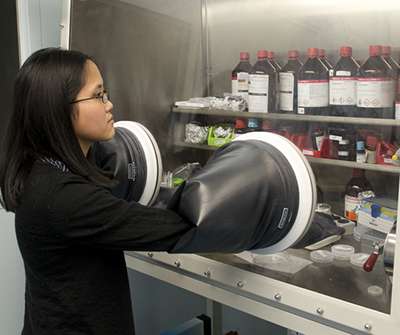Influential interfaces lead to advances in organic spintronics

Spintronics is an emerging field of electronics in which devices work by manipulating the quantum mechanical spin of electrons, in addition to their elementary electric charge. Just as conventional transistors have a source of electrons, a gate to control their movement, and a drain to carry off the charge signal, a spintronic circuit needs a well-controlled source of spin-polarized electrons that are injected into a transport channel material, a well-defined method of controlling the spin through the material, and a system to detect the spin signal. Additionally, it requires a transport channel material with long spin lifetimes because (polarized) spins fade away (i.e., become randomized) and lose their information during transport, unlike electric charges.
Compared to manipulating populations of moving electrons through a conventional semiconductor, controlling electron spins consumes much less energy and has the further advantage that its information content is "non-volatile": because the information is moved and stored in the form of magnetic states, it doesn't disappear when the electricity is turned off.
Spintronic devices made of inorganic materials are used today for read heads on hard disk drives, magnetoresistive random access memory (MRAM), and other applications. But recently there is growing worldwide interest in the use of organic materials, which offer numerous potential benefits:
- Spin-polarized electrons are predicted to have long lifetimes in organic semiconductors;
- Spin-based devices integrated with organic materials are expected to have low fabrication costs, light weight, and mechanical flexibility; and
- Organic materials have nearly limitless possibilities of chemical design that can be used to tune desired electronic and physical properties.
Designing, understanding, and controlling the interface formation between molecular semiconductors and ferromagnets are important to the development of organic spintronics because the interface plays a critical role in determining the efficiency of spin injection and detection. Scientists from PML's Semiconductor and Dimensional Metrology Division have performed studies on the way the interface between a ferromagnetic material (cobalt) and an organic semiconductor known as Alq3 can be altered by coating the cobalt with a single-molecule thick layer (monolayer) that affects the electron spin states of the cobalt. Cobalt is one of most widely used materials for spin injection/detection, and so is Alq3 for spin transport.
Project Leader Christina Hacker elaborates: "Cobalt surfaces are really interesting for electronic applications. If we can place molecular layers on them, and control the properties of that combination, it opens up a whole new range of things that we can do."
Cobalt oxidizes rapidly however, making it a challenging substrate on which to attach a monolayer.
In the first of two separate, but complementary studies, Hacker's team studied the effects of adding a self-assembled monolayer (SAM)3 to both a pure cobalt surface and a cobalt surface that was allowed to oxidize. The SAMs studied were octadecanethiol (ODT) and mercaptohexadecanoic acid (MHA). The SAMs' effects on the surfaces of the cobalt substrates were compared and contrasted. As a bifunctional molecule (i.e., molecules in which both sides can bond to a surface), the MHA provided especially interesting results.
"The oxidation at the interface was highly affected by those molecules which were bifunctional," explained Sujitra Pookpanratana, the lead scientist on this study. The data suggest that the MHA monolayer actually etched away much of the oxidized layer from the cobalt, allowing the cobalt atoms to become accessible at the surface, which is critical in electronic transport through the SAM and into the organic semiconductor. This finding suggests that the rapid oxidation of cobalt does not necessarily have to be a limiting factor in organic spintronics.
In the second study, the same molecular layers and the same substrate (cobalt, this time non-oxidized) were stacked onto a layer of Alq3. X-ray magnetic circular dichroism (XMCD) measurements were performed, in a collaborative effort with Stanford Synchrotron Radiation Lightsource, SLAC National Accelerator Lab, to examine the spin characteristics.
The SAMs altered the spin magnetic moment, morphology, and energy band alignment of the materials differently depending on the SAM being studied. In a critical finding, the data imply that the SAMs reduced the molecular hybridization between Co and Alq3, and, furthermore, enhanced the spin magnetic moment of Co at the interface which is expected to improve spin polarization at the point of spin injection into an organic semiconductor, Alq3.
Hyuk-Jae Jang, the leader of this study, explains the significance: "The interface between two different materials is very important in determining the performance and efficiency of electronic devices. By manipulating the interface between cobalt and Alq3, we show that there are a lot of things we can do to tune the spintronic characteristics of the organic-based device. Particularly from the XMCD measurements, we found that the spin polarization can be enhanced at the interface by simple interface engineering. This is helpful in efficient injection of the spin-polarized charge carrier from ferromagnetic materials to organic materials."
The current work is part of a long-term effort to understand how adjusting the composition of an interface with organic semiconductor materials can control spintronic properties.
"For a complete spintronic device, we need spin injection, spin transport, and spin detection," Jang explains. "Our latest work with SAMs only concerns the interface relevant to the spin injection part. The next step should be to find a better medium for spin transport since only short-distance—a couple of hundred nanometers—of spin transport has been demonstrated in organic materials such as Alq3 so far. There have been studies suggesting that long-distance spin transport in organics is achievable. Our grand plan is to make a whole device and show really long-distance (in this tiny device, over a micrometer) spin transport through an organic semiconductor."
More information: "Self-Assembled Monolayers Impact Cobalt Interfacial Structure in Nanoelectronic Junctions." Journal of Physical Chemistry C dx.doi.org/10.1021/acs.jpcc.5b00816
"Modifying spin injection characteristics in the Co/Alq3 system by using a molecular self-assembled monolayer." Journal of Physical Chemistry C dx.doi.org/10.1021/acs.jpcc.5b01222
Journal information: Journal of Physical Chemistry C
Provided by National Institute of Standards and Technology



















